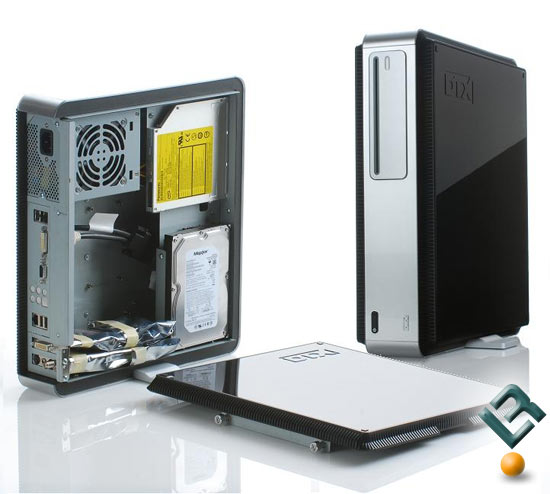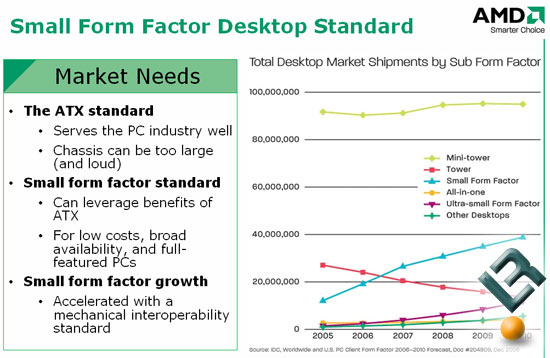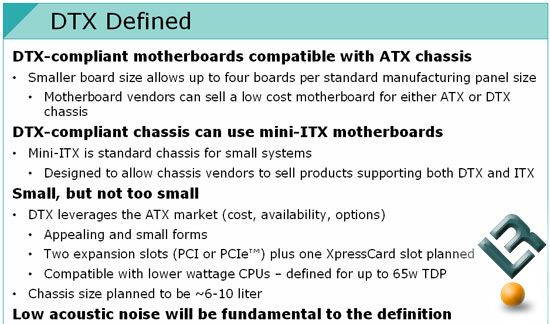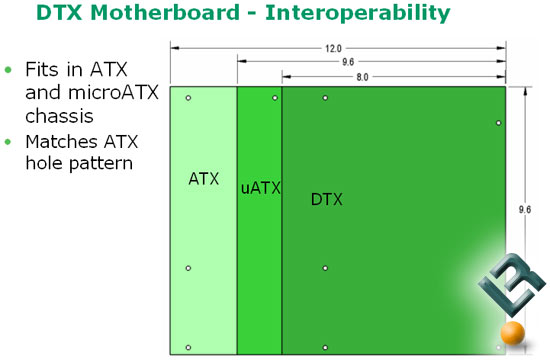AMD DTX Specification For Small Form Factor PCs
AMD’s DTX Form Factor Comes Closer To Reality
Back in January 2007, at the Consumer Electronics Show, AMD officially announced DTX, a new form factor specification designed to standardize small form factor motherboards. DTX was positioned as an open industry standard capable of supporting both AMD and Intel processors. Then months later in June 2007 at Cebit, AMD announced the finalization of the DTX specification and showed off a number of prototype systems like the one shown below. By the middle of the year it seemed that AMD was on track for giving system builders the ability to deliver smaller, quieter computing solutions for the home or office desktop, as well as other locations throughout home with the DTX specification.

Now, more than ten months after the official announcement, we finally have our hands on a DTX system and have been able to take it for a brief test drive. Before we show you the reference system and what it looks like on the interior and exterior, lets go over what DTX is and why AMD is promoting this specification.
DTX is an open standard specification being driven by AMD to help enable the development of small form factor systems. The DTX standard will empower OEMs, ODMs, and component vendors to design solutions based on open standards that can deliver new innovative systems to market, while leveraging commonalities within the ecosystem that can benefit customers and end users. How important are small form factor systems in the market?

Market research shows that the tower systems that we all grew up with are declining at a significant rate, while small form factor systems are greatly increasing. Since small form factor shipments are taking off it makes sense for a new specification to come out to replace ATX (Advanced Technology Extended) as it was not designed with small form factors in mind back when it was created by Intel in 1995. That is why other standards for smaller boards were introduced, which includes microATX, FlexATX and mini-ITX. In 2003, Intel announced a new standard standard known as BTX that was intended as a replacement for ATX. This form factor made it into some OEM computers, but never really took off. DTX comes as a natural progression from form factor standards ATX and BTX, although CTX is missing in action. With small form factor sales taking off the DTX form factor seems better thought out than the BTX form factor that failed to catch on a few years ago.

Relative to ATX, DTX is generally smaller, allowing DTX-compliant PCs to actually sit on desks instead of the floor as is the case with many ATX systems. The DTX standard leverages existing ATX infrastructure and the benefits thereof, including system options and backward-compatibility, allowing for innovative small form factors while using currently available components from the ATX ecosystem. While BTX attempted to be small, it still had to accommodate 100 watt+ CPUs, which was a good plan in 2003, but now in 2007 energy efficiency is a leading concern to consumers.

This means that a DTX motherboard will fit in any ATX or microATX chassis as they have the same mounting holes. This means any DTX motherboard can fit in an ATX form factor case and there are plenty of ATX cases are available today. If one is going for the smallest case they can get a true DTX case will of course be smaller as a DTX motherboard is 203mm x 244mm whereas the ATX motherboard is 305mm x 244mm. DTX chassis can also support mini-ITX motherboards, which are 170mm x 170mm. Now that we know what DTX is and how versitle the design is with current chassis, lets take a look at the reference system!

Comments are closed.